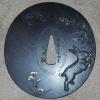
Peter Bleed
-
Posts
1,863 -
Joined
-
Last visited
-
Days Won
8

Peter Bleed replied to JAMJ's topic in Tosogu


Peter Bleed replied to 400 year old katana needs restorati's topic in Nihonto
Jeremiah,
I can't figure out how to sent you or the list the Kunikane Excel sheet? Please advise!
Peter
Peter Bleed replied to a topic in General Nihonto Related Discussion
Peter Bleed replied to Peter Bleed's topic in Assorted Samurai, Japanese Art and Related Items

